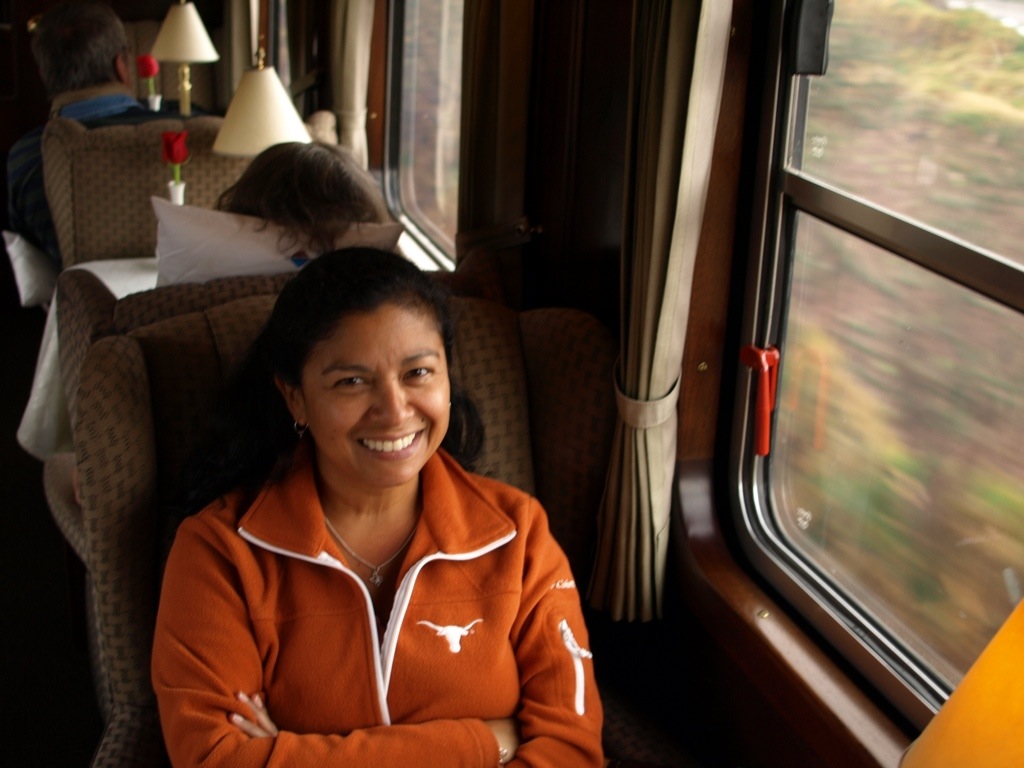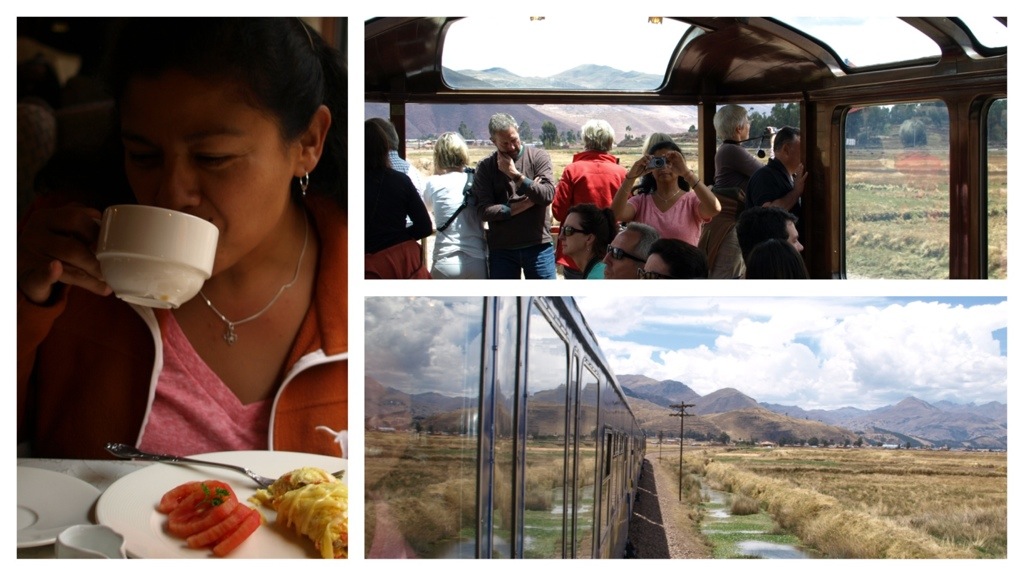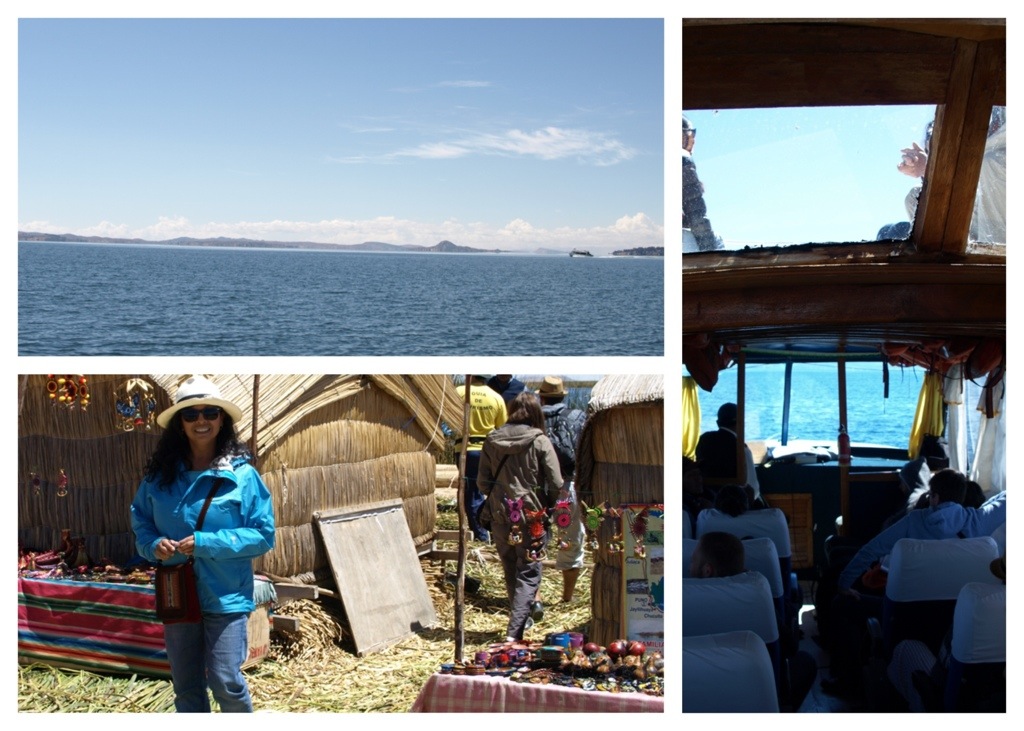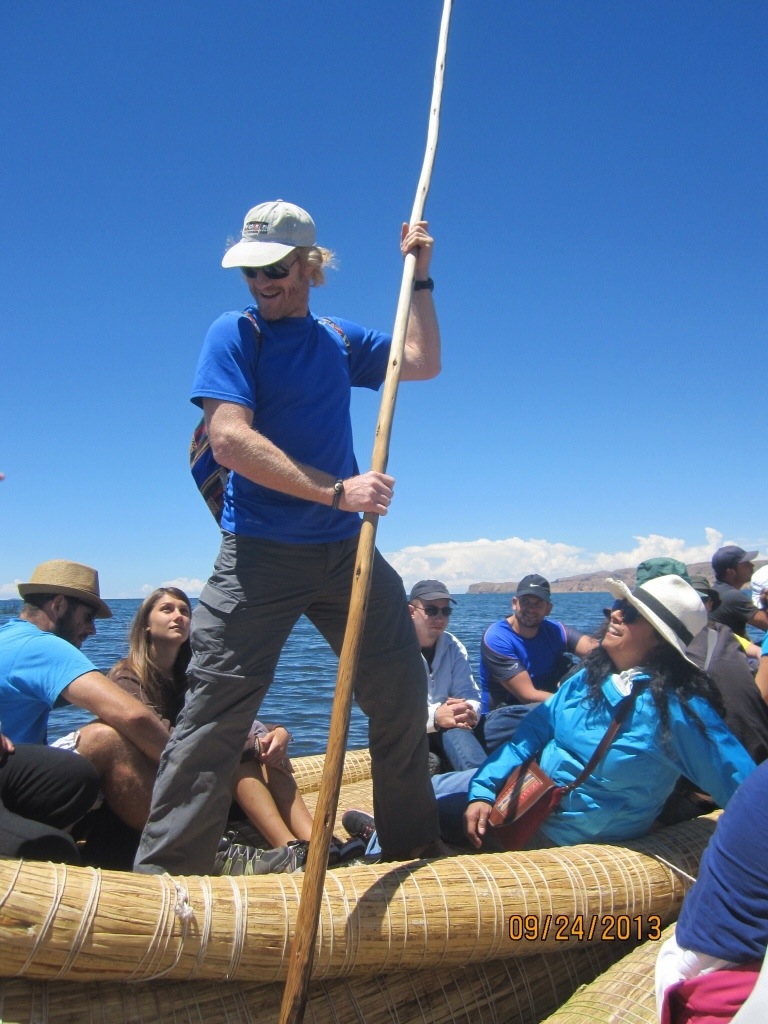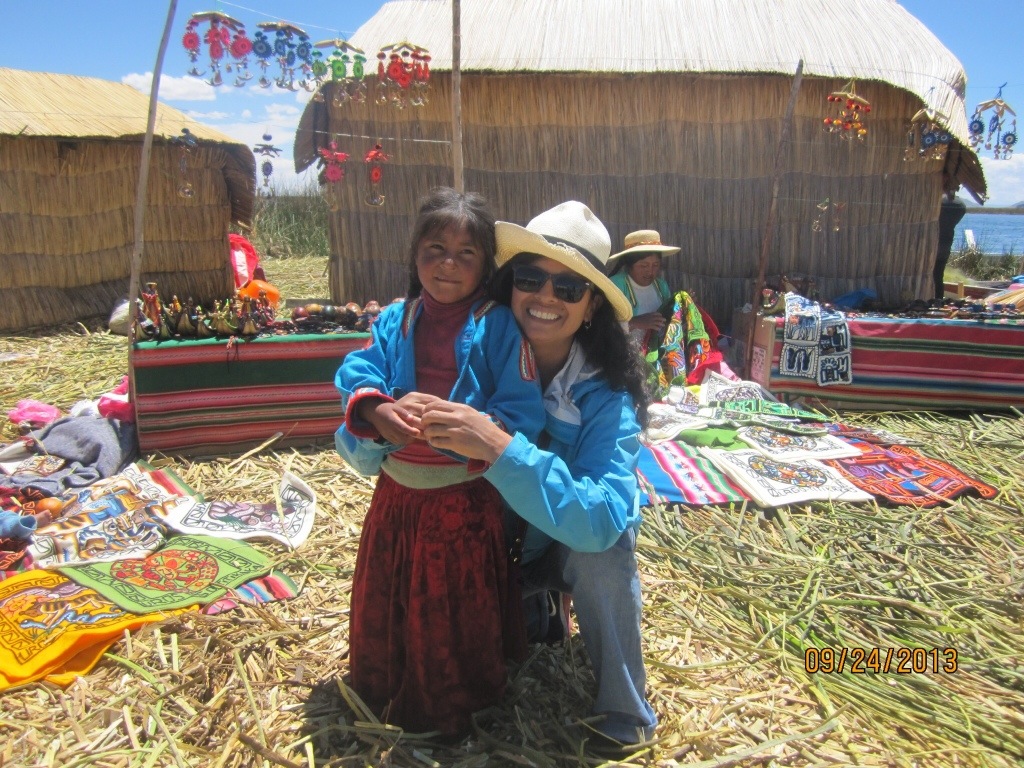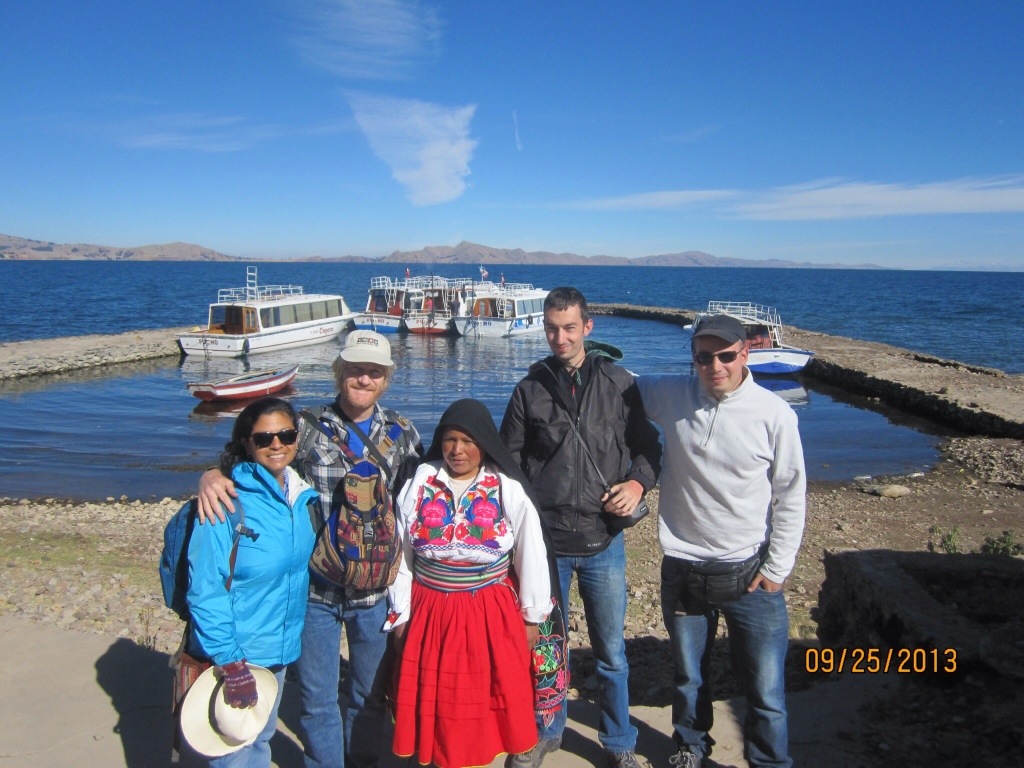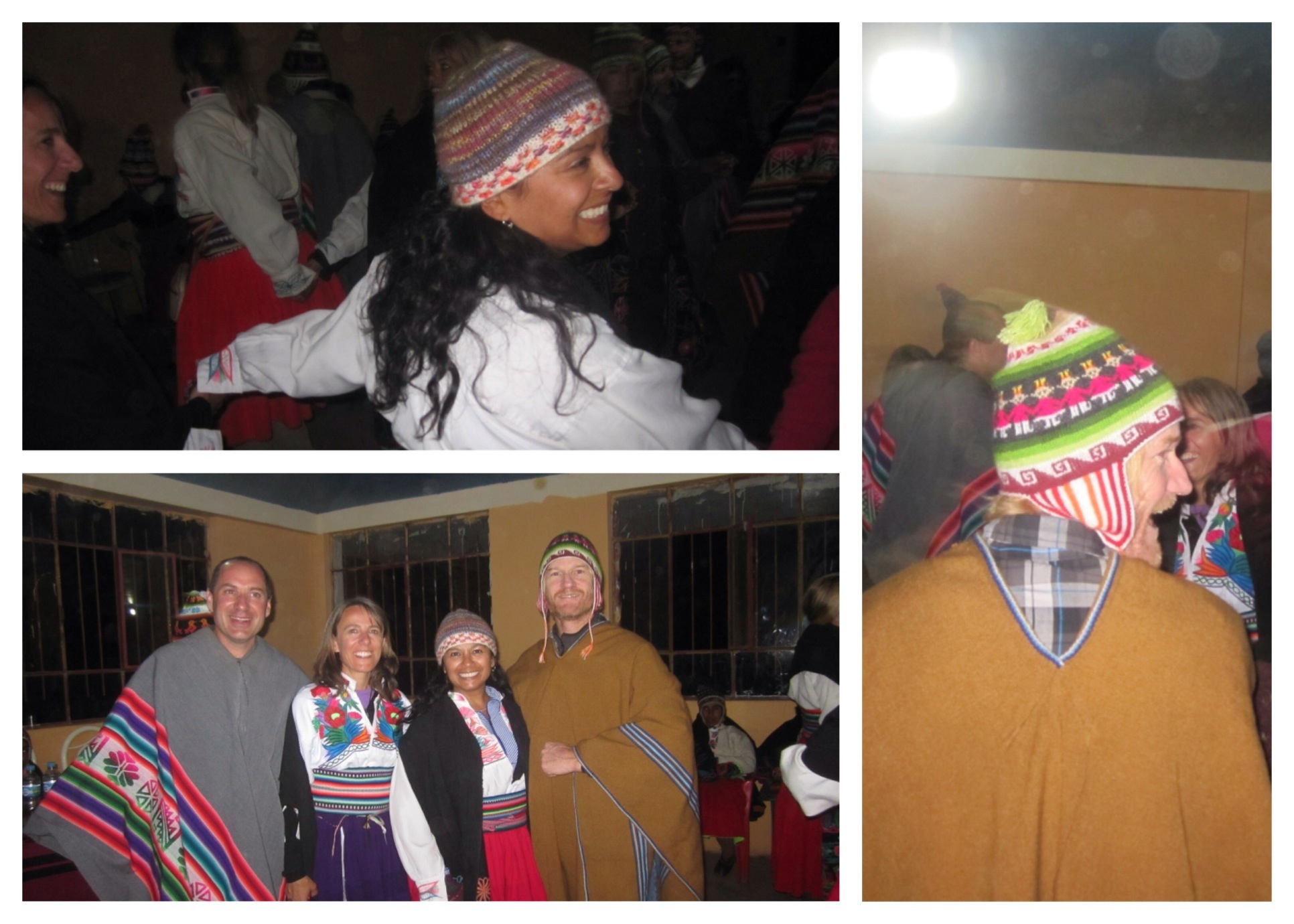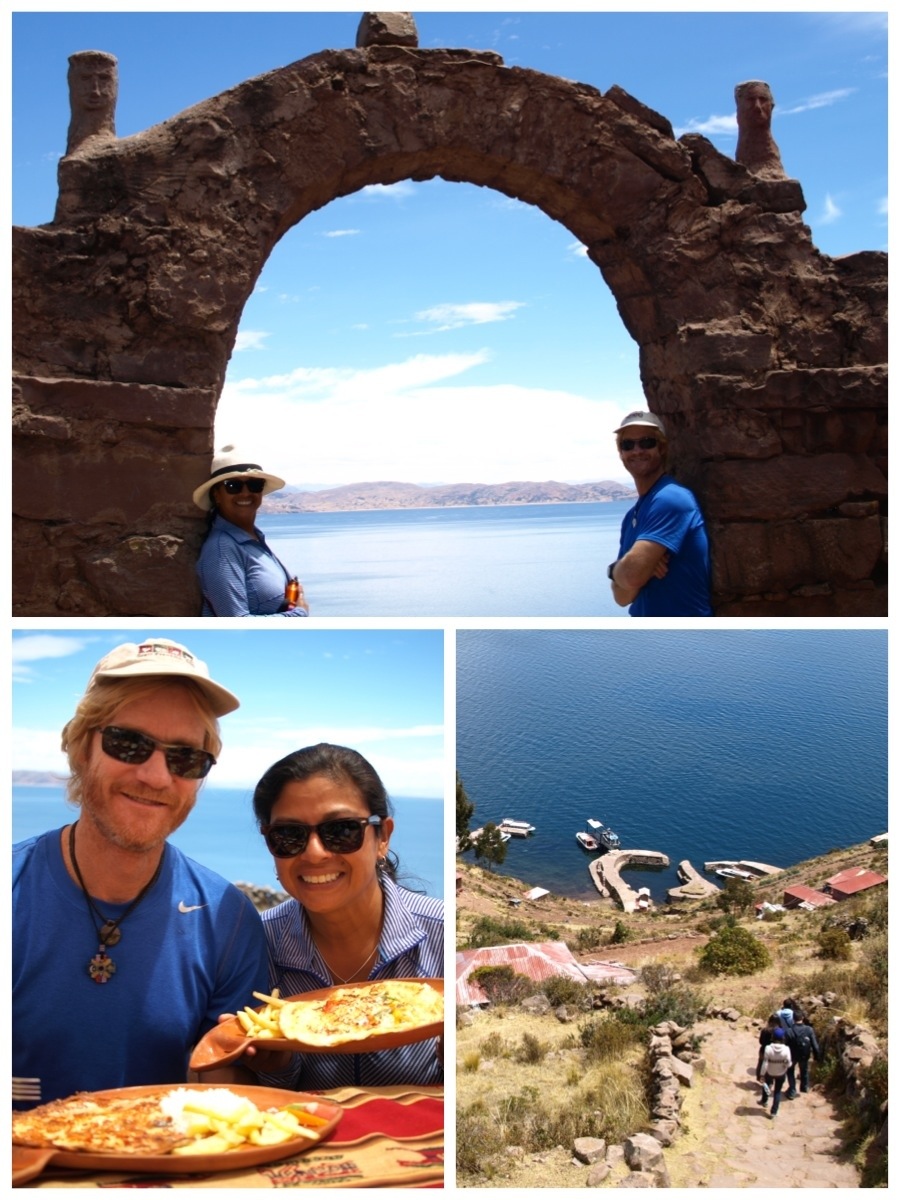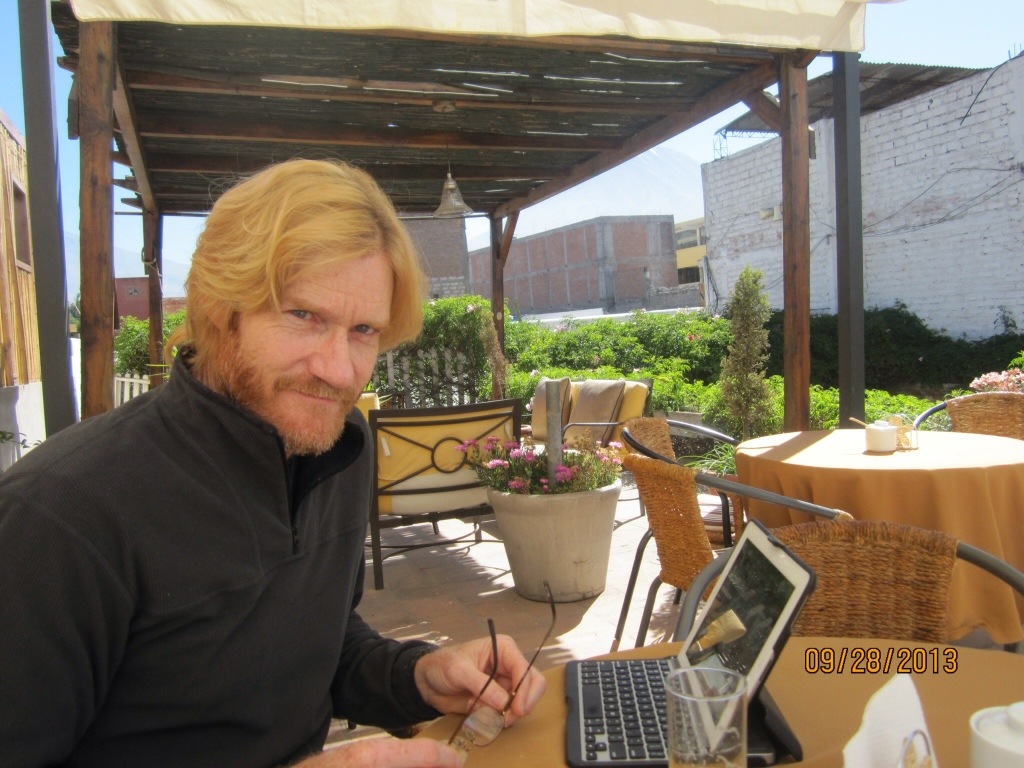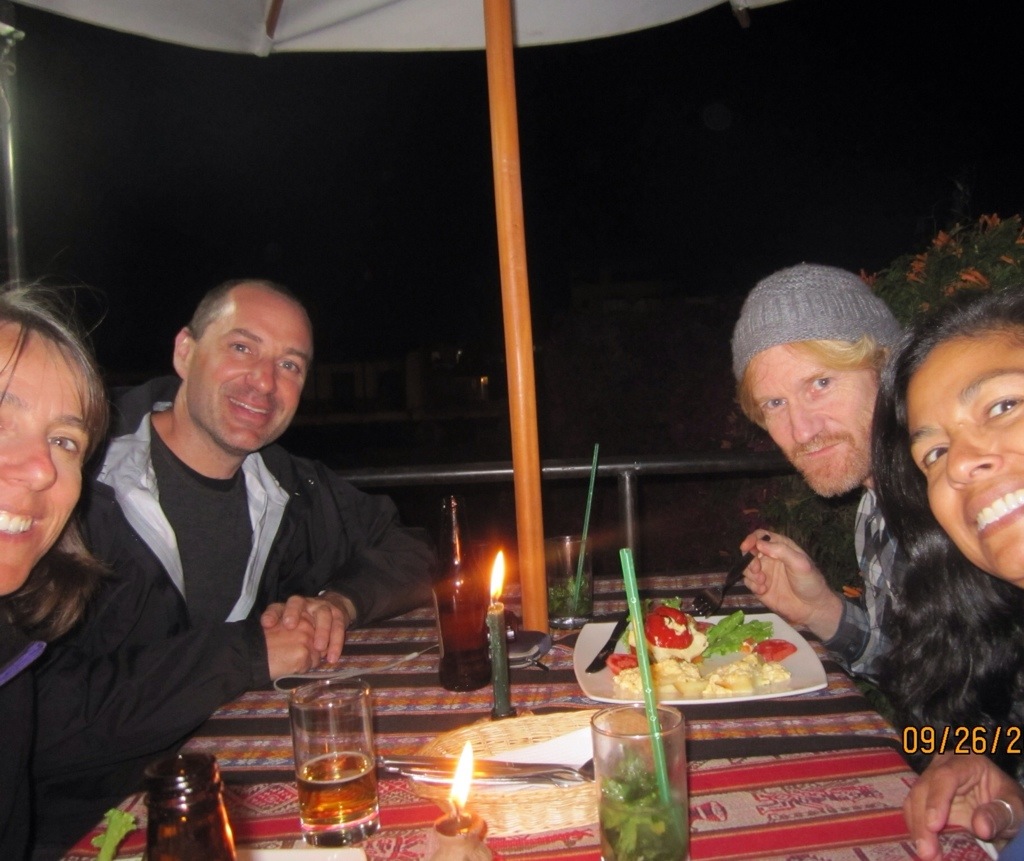(Lake Titicaca & Arequipa, Peru – 30 Sept, 2013) Our hike of the Inca Trail was definitely the high-point of our time in Peru. Originally, it was to be our final stop; the crescendo in a 16 day Peruvian symphony. However, our travel plans were forced to change after my ankle ended up in a cast one day after we arrived into Lima. The result, instead of hitting Arequipa and Lake Titicaca before the Inca Trail, we flipped the order and saw them afterwards. Nothing was going to beat Cusco, the Inca Trail and Machu Picchu, but still Lake Titicaca and Arequipa were two destinations I had not visited the last time I was in Peru (some 14 years ago) and damn if I was going to miss them again.
Jessica was less enthusiastic about these locales and would have been fine heading straight to Chile after Machu Picchu, but we are travel partners to the end; where one goes so goes the other.
Train!
Travel from Cusco- the main city nearest to Machu Picchu -to Puno- the largest city on Lake Titicaca – could be accomplished by car, bus or train. A car, we don’t have. A bus would certainly work and (by far) be the cheapest way to go, but who doesn’t love a train ride, right? Especially after we heard the train ride between Cusco and Puno is considered by many to be one of the top three train rides in all the world! The other two top contenders are somewhere in the Canadian Rockies and Switzerland. Hmmmm… Maybe this train idea deserves some serious consideration.
Jessica and I boarded the train at 7:45 on a cool Monday morning. Whoa! Tommy the Train this was not. Each passenger car was appointed with white linen covered tables and Ethan-Allen style upholstered chairs. These were not the rows of bus-seats we were expecting. A lovely fresh-cut rose dressed each table leaving no doubt this train was aiming for hoity-to-the-toity. A glance around the car found mostly grey-haired (or balding) retirees and at least one gentleman wearing an ascot.
Yes, I felt a skoasch out of place among all the richy-riches (Jessica did not, btw), but that wasn’t about to diminish my enjoyment of this experience one bit. The train chugged away from the station right on schedule and our 10 hour journey through the Andean landscape was underway.
The last train car was different from the others. Its front half was set up as a bar/lounge area with the final half reserved for panoramic viewing. Can you find Jessica in all 3 pics?
Click Here to check out the little movie I put together of our super-splurge train ride. Watch for the choreographed food service at the end.
Below is a shot of the only stop the train made during our journey. It was a 10 minute souvenir stop made at both the half-way and highest altitude point of our ride.
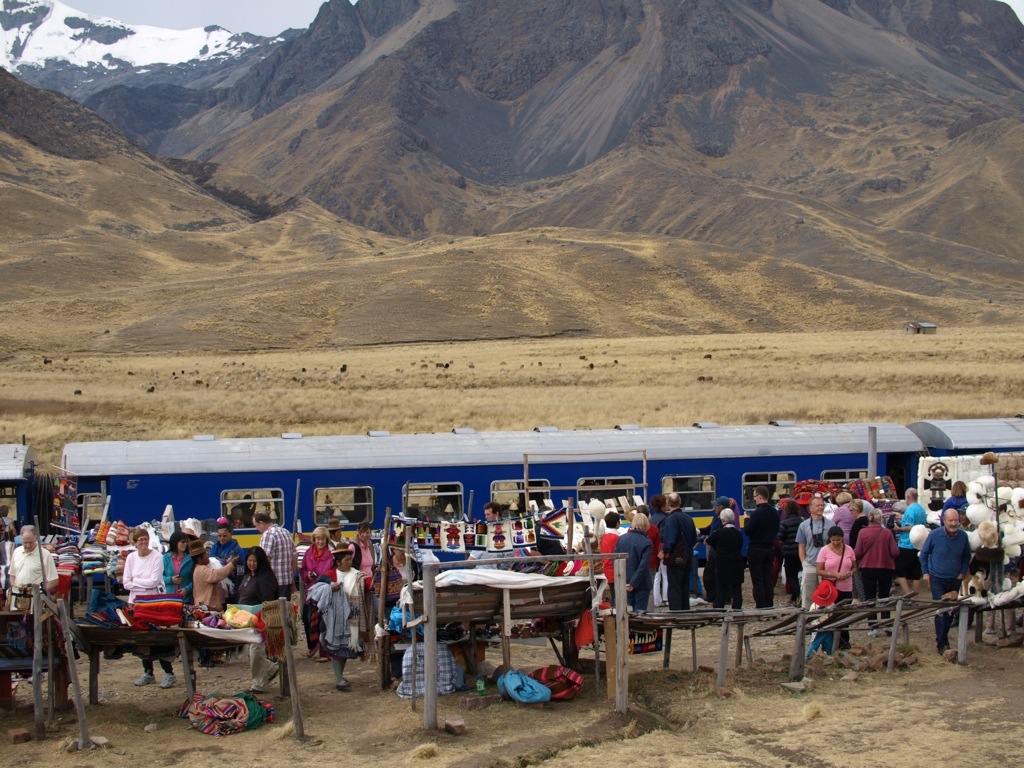
Islands That Float
Once in Puno we grabbed a back-to-reality cheap place to stay and worked on our plans for the next day- a visit to Lake Titicaca, the Uros floating islands, and an overnight stay on one of the Lake’s natural islands. Perhaps some brief explanations would be helpful.
Lake Titicaca is famous for being the highest altitude navigable lake in the world. There are other lakes that sit higher than Titicaca, but none large enough and deep enough to handle big ships like this one can. It measures 233 km (145 miles) across at its longest point and and 97 km (60 miles) wide in the other direction. Our tour guide said it was up to 280 m deep in places, but that seems REALLY deep and I’m not sure I believe him. On the day we were out on the lake, it was clear enough for the far shores to be visible in all directions. The panoramic is stunning. It’s one of those unique places on the planet where capturing the curvature of the earth in one vista is as easy as breathing.
From the boat dock in Puno we hopped into the little ship’s belly with about 20 other tourists and began a slow-motion cruise into the quiet waters of Lake Titicaca. No exaggeration, we were traveling at the wake-quaking speed of 2-3 mph. This was our speed when we departed from the dock and it never increased. I was so curious about the astonishingly slow course we’d set that I asked our guide about it. I figured he would tell me the lake had strict speed limits to preserve the yadda-yadda. Nope. Instead, he explained that we were in a normal boat. “Fast” boats are allowed on the lake, but they cost much more. Not during our entire time on the lake did I witness any of the so-called fast boats.
It took us about 1 1/2 hours to reach one of the Uros floating islands. [Wikipedia gives a better explanation of what these are than I could.]
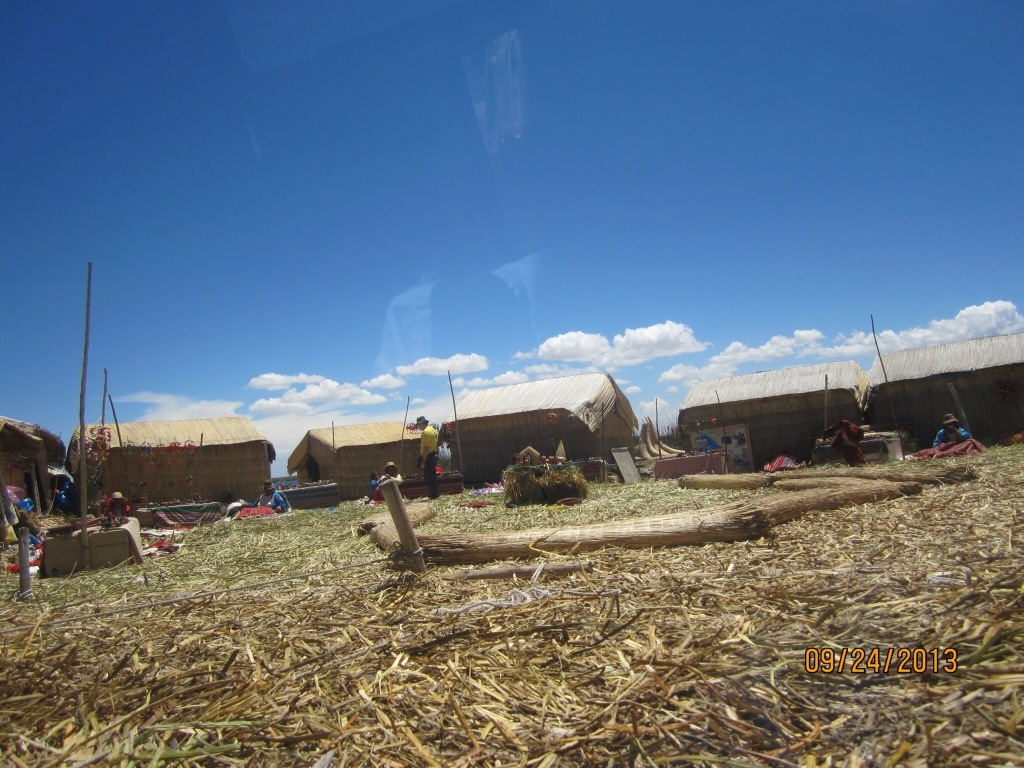 Stepping off our tour boat and onto the parade-float-sized bed of totora reeds was strange indeed. The texture underfoot was that of a Sealy Posturepedic mattress…. made of straw. There were five or six little house-huts on the island and about that many people- mostly just the women and children were there when we arrived. Such a weird dynamic, we are there for a brief glimpse into their unique way of life and they are there to sell us hand-made trinkets.
Stepping off our tour boat and onto the parade-float-sized bed of totora reeds was strange indeed. The texture underfoot was that of a Sealy Posturepedic mattress…. made of straw. There were five or six little house-huts on the island and about that many people- mostly just the women and children were there when we arrived. Such a weird dynamic, we are there for a brief glimpse into their unique way of life and they are there to sell us hand-made trinkets.
Part of our tour to the Uros islands included a spin on one of their stick-powered reed boats.
Amantani, A Real Island
Lake Titicaca has many natural islands within it (in addition to the man-made Uros islands). Two of the largest such islands are Amantani and Taquile. Our tour included one night’s stay with a local family on Amantani island and then lunch on Taquile island the next day. Staying with a family was a part of this adventure we were really excited about. However, the reality of the experience didn’t quite match the hype.
Upon landing on Amantani, we were greeted at the dock by the mama of our host family. She softly introduced herself as Luz-Delia. Jessica and I were paired up with two twenty-something dudes from France, and together we followed Luz-Delia up the narrow pathways to her humble abode.
The family’s house had two extra rooms that appeared to have been built within just the past few years, and built quite specifically to house visiting tourists…like us. I read somewhere that the local communities used to benefit little from the tourist trade, but eventually got organized and made some demands. They petitioned the Peruvian government’s Department of Tourism to participate more directly with the tourist and reap a greater share of the economic rewards. The result, we were able to stay in a comfortable room owned by Luz-Delia and the rest of her Quechua family on a remote island in the middle of Lake Titicaca. The family served us lunch and dinner the day we arrived, and also breakfast the next day. To our disappointment, however, no one from the family actually sat and ate with us. The interaction we had was more as if we were staying at a B ‘n B, as opposed to us being foreign exchange students living with a host family. All good, but not quite the immersive cultural experience we were hoping for.
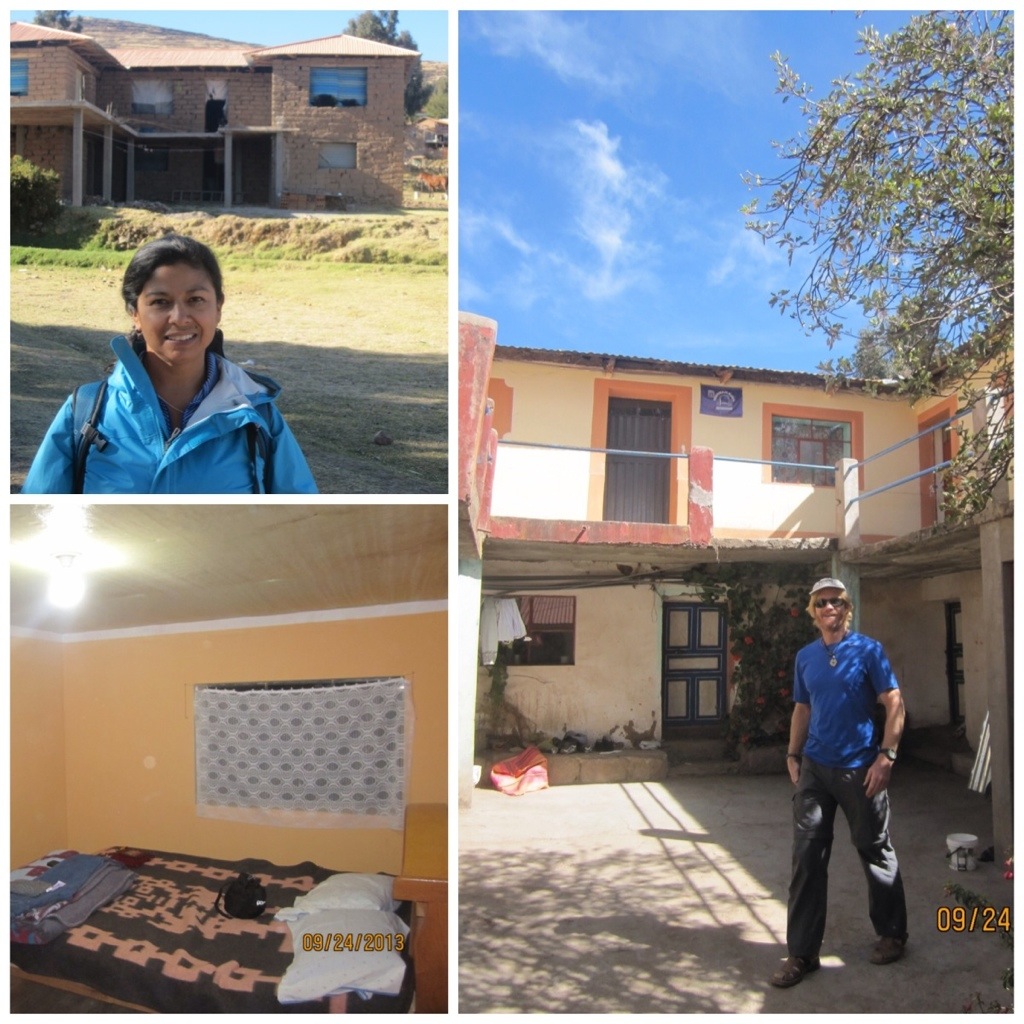
We did interact a bit with the 15 year old daughter of the family, Delia (different from her mother, Luz-Delia). It was Delia that accompanied us to a festive “dance” the night of our stay. Wearing traditional local attire, Jessica and I danced it up with the best of them.
Quiet. It struck me over and over again just how quiet it was on Amantani. There were no cars, no trucks, no motorcycles, no leaf blowers, no radios blaring, no dogs barking (we were told there were no dogs on the island)….occasionally  you might hear a cow moo or a donkey brae, but that was about it. Such a simple life. Our guide insisted the people didn’t even have electricity; though this was clearly not the complete story. We could see that nearly everyone had a solar panel on their roof hooked up to a couple of car batteries; a simple schematic, but sufficient to power a small television set and a lightbulb in every room.
you might hear a cow moo or a donkey brae, but that was about it. Such a simple life. Our guide insisted the people didn’t even have electricity; though this was clearly not the complete story. We could see that nearly everyone had a solar panel on their roof hooked up to a couple of car batteries; a simple schematic, but sufficient to power a small television set and a lightbulb in every room.
(For the record, Delia told us there were actually 5 dogs on the island.)
Standing on Amantani. Taquile island is behind me.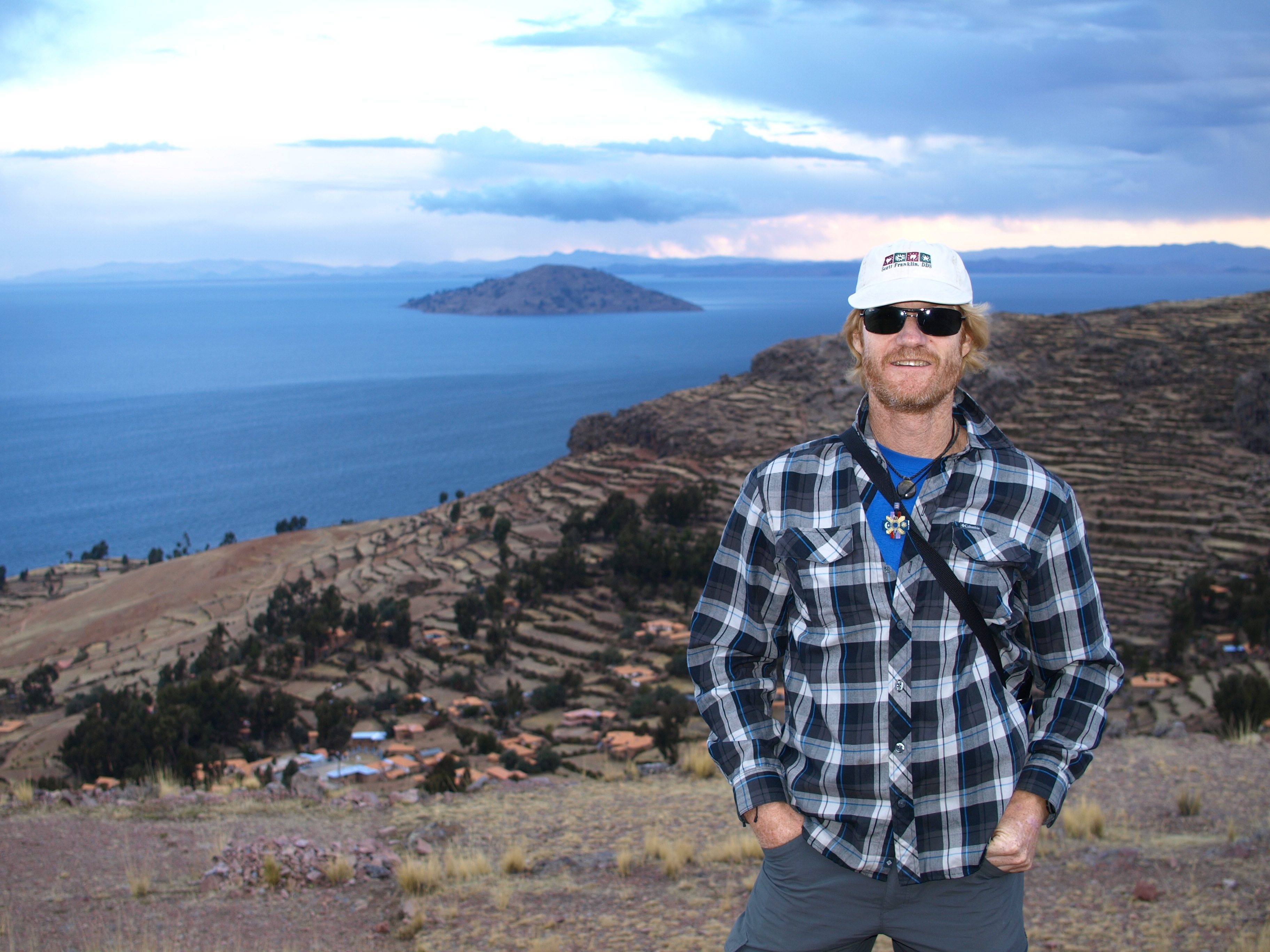
Taquile, Not Tequila
The guide during our Lake Titicaca tour was highly enthusiastic and interesting but quite unfortunately exhausting to listen to. What great potential he had, too. His name was Ruben and he grew up on the Uros islands so obviously he knew the lake and its people well. He spoke four languages: Aymara, Quechua, Spanish and lastly…English. During the tour he spoke both Spanish and his (disturbingly poor) version of English. For us (with our substantial Spanish skills) this meant hearing his disjointed schpeels at least twice. More often, though, we endured him repeating himself many more times than twice as he would often forget to switch languages. We might get Spanish, Spanish again, and then English.
Here Ruben explains that the ends of the totora reeds are edible. Jessica and I both took a bite. Needed salt.
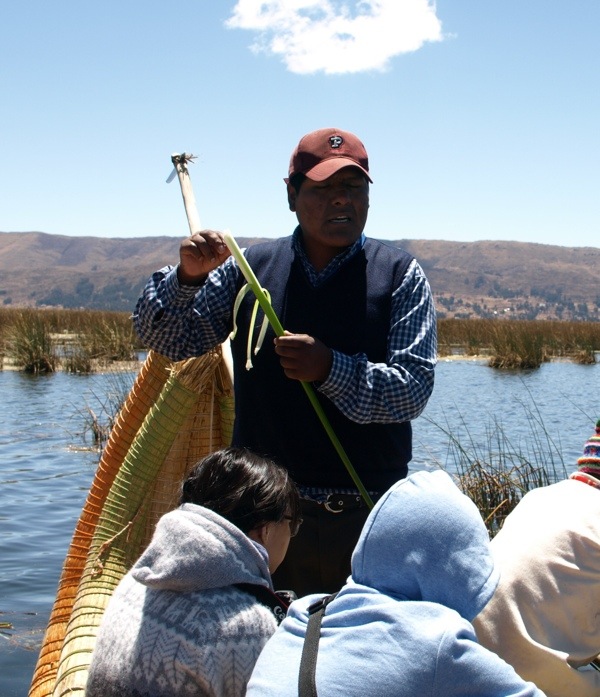
Ruben was also hell-bent on getting us to learn a word or two in Aymara and Quechua. No more than simple terms like, Hello, I’m fine, and Thank you. But I’m sorry, Ruben, those languages are tough and asking your group to learn six new foreign language words/phrases (3 in each language) in 2 minutes ain’t happening.
Once we had arrived onto la Isla de Taquile, Ruben herded our group around the island like goats. Every so often he would stop and explain to us certain facts about the island’s history and its people. Within his talks, inevitably, Ruben would say slowly and deliberately the word, “Taquile” followed by the reminder, “…not tequila.” Throughout the day, he did this so many times someone from the group suggested we make it into a drinking game. It practically became a call-and-response mantra between him and the group. Ruben: “Taquile” Us: “Not tequila.” Ruben seemed unaware the entire time.
A Thief in the Night
The final stop on our tour through Peru was Arequipa, known for its many “white” buildings made from sillar, a particular volcanic stone common to the area. (The name of the stone in English is ashlar.) The buildings are not truly white, by the way, but close enough. Among Peruvian cities, Arequipa is perhaps the most…uh…civilized. At least things seem more orderly and less chaotic than in other Peruvian cities we’d visited.
To get from Puno to Arequipa, we boarded an evening bus and took residence in the lower “VIP” section. That’s where they have the larger seats that recline like Laz-e-Boys. We left the terminal at 6 PM and would arrive into Arequipa around midnight. The on-board lights were soon dimmed and a great chance to rest had found us. Jessica slipped off to sleep first and I listened to some music for a short while before similarly closing my eyes.
Occasionally, you will hear stories from other travelers about how they got robbed while going from place to place. Way back when we were in Costa Rica one guy told me he’d been mugged twice while traveling through Nicaragua (I think it was). One guy had his backpack taken while on a train (in Europe). And then of course, there are the stories of people having their things stolen from them while traveling on the buses….especially at night! Yikes!
All of this was going through my head as I reclined there in my bus seat and tried to drift off to sleep. My backpack was down at my feet so I looped my leg through one of the straps. Surely, if anyone creeps in to snatch my bag while I’m asleep, I’ll feel it and catch the little perp in the act. But, then…that’s not comfortable…having that strap around my leg was restricting my movement. I repositioned myself so that my leg was out of the strap but still leaning against the bag. I’m so ready to sleep, but my sloshy mind starts to rehearse what I might do if I actually catch someone stealing from us. But still so sleepy. Eventually, slowly, lazily… I slip into sleepville.
What’s happening!? I feel something! This is it! This is the moment I’d prepared for! With those last unconscious thoughts I opened my eyes and saw a slinky silhouette crossing at my feet! My arms instinctively rallied into fight mode. My head is thinking, I got you, you little perp!
Then, as my eyes come into focus, I see that it’s Jessica trying to cross over from her seat to the aisle. She’s midway through her maneuver and looking at me with a laugh. “Oh, sorry. I was trying so hard not to wake you.” “What’s with all the [she mimics my crazy fighting arms movement]?” I tell her that I thought she was little Peruvian girl, come to steal our bags.
By then Jessica is laughing so hard she’s ready to pee in her pants, after all, she was getting up to go to the bathroom. “You should have seen your face,” she keeps telling me. After she returns from the bathroom she’s still laughing uncontrollably. I guess my thief-catching face is more funny than brave.
Four Days Relaxing in Arequipa
As a travel destination, Arequipa doesn’t necessarily have a main attraction…it IS the main attraction. Simply a nice city with highly walkable streets and an ample number of interesting landmarks to entertain visitors. Colca Canyon- the deepest terrestrial canyon in the world -is a nearby hiking hotspot, but at 5 hours away (and only accessible in a 4×4 vehicle), it’s not close enough to Arequipa to qualify as a main attraction.
Enjoying a city tour in Arequipa. Jessica beneath some arches made from the white volcanic stone called sillar. Street food!

Hostels in Arequipa were generally more expensive than Jessica and I had become accustomed to in other parts of Peru. I think we paid $42/night at the Hostel Solar in Arequipa… though we really loved it. Our room was the largest of any we’d stayed in. The ceilings must have been 15 feet high! Breakfast was included in the price and served on the building’s cool roof-top terrace. While sipping coffee (Jessica), and orange juice (me), we admired two of the three snow-topped volcanos that immediately surround Arequipa. (The third volcano was behind a building.)
Two of the friends we’d made while on the Inca Trail (Caroline and Patrick (from Quebec)) were traveling on a similar trajectory as us and we were pleased to meet them for dinner in Arequipa several times. Feeling like you have friends out on the road is a wonderful sensation. (Though, it does prompt us to miss our friends and family from back home.)
My first ever shoeshine!
After Arequipa we plunged headlong into a day and a half of travel before arriving to Santiago, Chile, the next stop on our world tour. That double-scoop of travel included a 17 hour overnight bus ride from Arequipa to Lima, followed immediately by an Amazing Race style cab ride from the bus terminal to the airport. They recommend arriving 3 hours early for International flights; we only had 1 hour to give. We were jumping airport lines like criminals, but we managed to make our flight in time and not get arrested. Three separate flights and 12 hours later, we were in Santiago.
Travel days can be hell. But our plan now is to slow down the pace for about a month. What will that look like? Return for the next post and find out.

